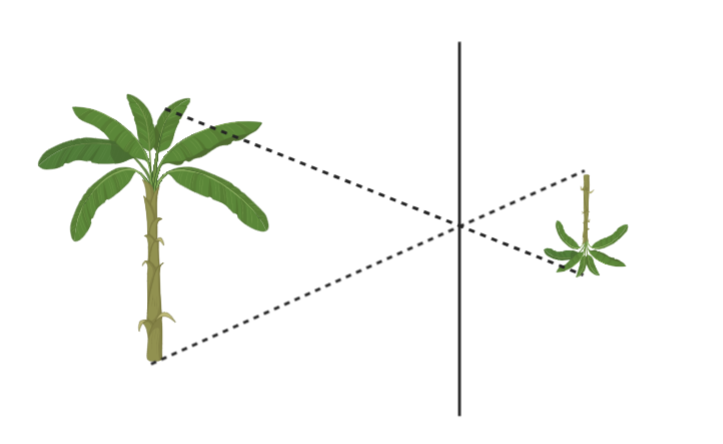
Images are inverted in a pinhole camera because:
(A) Light travels in a straight line
(B) Images are always inverted
(C) Images get inverted when light travel through a hole
(D) There is no specific reason
Answer
218.4k+ views
Hint An image formed by reflection can be real or virtual. A real image occurs when light rays actually intersect at the image, and become inverted, or turned upside down. A virtual image occurs when light rays do not actually meet at the image but appear to be met.
Complete step by step answer:
The light rays that come from the object get reflected from the plane mirror and reach our eyes. As they touch eyes our brain feels that the reflected ray is coming from inside the mirror. That is why the image of the object seems to be laterally inverted.

Such upside down inversion also occurs when you see yourself in a spoon on the concave side.
This phenomenon occurs obeying laws of reflection and laws of rectilinear propagation; which is light travels in a straight line.
Hence option A is correct.
Note Magnifying glasses are made of convex lenses. A convex lens can make objects look larger because it disperses the light. When objects are magnified, they are within the focal length of the magnifying glass. The focal length is defined as the distance between the center of the lens and its focus, the point where an object can be viewed clearly through a lens.
Complete step by step answer:
The light rays that come from the object get reflected from the plane mirror and reach our eyes. As they touch eyes our brain feels that the reflected ray is coming from inside the mirror. That is why the image of the object seems to be laterally inverted.

Such upside down inversion also occurs when you see yourself in a spoon on the concave side.
This phenomenon occurs obeying laws of reflection and laws of rectilinear propagation; which is light travels in a straight line.
Hence option A is correct.
Note Magnifying glasses are made of convex lenses. A convex lens can make objects look larger because it disperses the light. When objects are magnified, they are within the focal length of the magnifying glass. The focal length is defined as the distance between the center of the lens and its focus, the point where an object can be viewed clearly through a lens.
Recently Updated Pages
A square frame of side 10 cm and a long straight wire class 12 physics JEE_Main

The work done in slowly moving an electron of charge class 12 physics JEE_Main

Two identical charged spheres suspended from a common class 12 physics JEE_Main

According to Bohrs theory the timeaveraged magnetic class 12 physics JEE_Main

ill in the blanks Pure tungsten has A Low resistivity class 12 physics JEE_Main

The value of the resistor RS needed in the DC voltage class 12 physics JEE_Main

Trending doubts
JEE Main 2026: Application Form Open, Exam Dates, Syllabus, Eligibility & Question Papers

Derivation of Equation of Trajectory Explained for Students

Hybridisation in Chemistry – Concept, Types & Applications

Understanding the Angle of Deviation in a Prism

Understanding Collisions: Types and Examples for Students

Understanding Atomic Structure for Beginners

Other Pages
JEE Advanced Marks vs Ranks 2025: Understanding Category-wise Qualifying Marks and Previous Year Cut-offs

How to Convert a Galvanometer into an Ammeter or Voltmeter

Understanding Centrifugal Force in Physics

JEE Main Marking Scheme 2026- Paper-Wise Marks Distribution and Negative Marking Details

Degree of Dissociation: Meaning, Formula, Calculation & Uses

Understanding Electromagnetic Waves and Their Importance




